Argentina · Attractions · Bolivia · Brazil · Chile · Colombia · Ecuador · Going Out · Peru · Regions · South America
10 must-see natural wonders of Latin America
Latin America has achieved a reputation for being rich in natural beauty and grandiose wonders. While the continent boasts multitudes of natural wonders, here are my top picks to get a healthy dose of nature on your next adventure in Latin America.
1. Amazon rainforest
Of course, the Amazon rainforest is my number one pick, mainly because you could spend a month there and see something new and spectacular each day. Sprawling across 5.5 million square kilometers (2.1 million square miles) and 7 different countries, the Amazon rainforest is the largest and most biodiverse tropical habitat in the world. With the majority of the rainforest situated in Brazil (60%), Peru (13%) and Colombia (10%), this natural sanctuary thrives on the flow of the Amazon River and its tributaries, which begin in the Andes Mountains of Peru and empties 6,437 kilometers (4,000 miles) away into the Atlantic Ocean on the northeastern coast of Brazil.
 Each country has numerous sights to witness, such as the thousands of species of flora and fauna living in over 50 national parks, wildlife reserves, and sanctuaries found in Peru, or the worlds largest chain of freshwater islands, the Anavilhanas archipelago of Brazil. Enjoy a cruise down the Amazon River, a nature hike packed with wildlife, a piranha fishing trip, or perhaps a cultural exchange with the indigenous people. With so much to offer, the Amazon Rainforest will surely be an exciting adventure to add to your South America vacation.
2. Uyuni Salt Flats (Salar de Uyuni) in Bolivia
Take a walk through the largest field of salt in the world at the Uyuni Salt Flats in the southwestern part of Bolivia. Spanning across an area of more than 10,500 square kilometers (6,524 square miles), the Uyuni Salt Flats are the remnants of a number of prehistoric lakes which previously occupied the Bolivian Altiplano. Not only famous for its large quantities of salt deposits, these salt flats also contain the single largest lithium reserve in the world, which is found in the brine (salt and water mixture) hidden deep beneath the salt flats.
Each country has numerous sights to witness, such as the thousands of species of flora and fauna living in over 50 national parks, wildlife reserves, and sanctuaries found in Peru, or the worlds largest chain of freshwater islands, the Anavilhanas archipelago of Brazil. Enjoy a cruise down the Amazon River, a nature hike packed with wildlife, a piranha fishing trip, or perhaps a cultural exchange with the indigenous people. With so much to offer, the Amazon Rainforest will surely be an exciting adventure to add to your South America vacation.
2. Uyuni Salt Flats (Salar de Uyuni) in Bolivia
Take a walk through the largest field of salt in the world at the Uyuni Salt Flats in the southwestern part of Bolivia. Spanning across an area of more than 10,500 square kilometers (6,524 square miles), the Uyuni Salt Flats are the remnants of a number of prehistoric lakes which previously occupied the Bolivian Altiplano. Not only famous for its large quantities of salt deposits, these salt flats also contain the single largest lithium reserve in the world, which is found in the brine (salt and water mixture) hidden deep beneath the salt flats.
 Due to the unusually flat surface, this natural wonder is the perfect backdrop to take some really creative and surreal pictures that toy with artistic perspective. Here is a little insider tip: the best time to visit is shortly after it rains so that the pools of water that collect on the flats create a vivid reflection like something out of M.C. Escher’s sketch pad.
3. Perito Moreno Glacier of Patagonia in Argentina
The glaciers of Patagonia are a must-see for anyone traveling to the southern part of Latin America. Patagonia itself is a semiarid plateau region that spans across the borders of Chile and Argentina, encompassing an area of approximately 670,000 square kilometers (260,000 square miles).
Due to the unusually flat surface, this natural wonder is the perfect backdrop to take some really creative and surreal pictures that toy with artistic perspective. Here is a little insider tip: the best time to visit is shortly after it rains so that the pools of water that collect on the flats create a vivid reflection like something out of M.C. Escher’s sketch pad.
3. Perito Moreno Glacier of Patagonia in Argentina
The glaciers of Patagonia are a must-see for anyone traveling to the southern part of Latin America. Patagonia itself is a semiarid plateau region that spans across the borders of Chile and Argentina, encompassing an area of approximately 670,000 square kilometers (260,000 square miles).
 The Perito Moreno Glacier is the largest glacier located in Glacier National Park in the western part of Argentina, which includes a total of 13 glaciers that descend into two large lakes. Not only is it the largest, but Perito Moreno is also the most active glacier in the park, as it is constantly advancing across the surface of Lake Argentina at a rate of about 7 feet per day. It is it one of few glaciers in the world which seems to not have been affected by global warming.
The glacier is truly a humbling experience. Visitors can get up close and personal with the creeping ice giant from a boat on Lake Argentina or hiking along the perimeter of the lake. There is even an option to hike on the glacier itself!
4. Iguazu Falls in Brazil and Argentina
Arguably one of the most majestic natural wonders in Latin America, Iguazu Falls is a J-shaped waterfall that lies on the border of Argentina and Brazil. Designated as a UNESCO World Heritage site in 1984, this breathtaking site measures about 2 kilometers (1.2 miles) in diameter with the cascading waters of the Iguazu River plunging over the Paraná Plateau from a height of approximately 80 meters (262 feet). The monumental drop produces a cloud of spray which creates a subtropical microclimate that supports a wide variety of exotic flora and fauna.
The Perito Moreno Glacier is the largest glacier located in Glacier National Park in the western part of Argentina, which includes a total of 13 glaciers that descend into two large lakes. Not only is it the largest, but Perito Moreno is also the most active glacier in the park, as it is constantly advancing across the surface of Lake Argentina at a rate of about 7 feet per day. It is it one of few glaciers in the world which seems to not have been affected by global warming.
The glacier is truly a humbling experience. Visitors can get up close and personal with the creeping ice giant from a boat on Lake Argentina or hiking along the perimeter of the lake. There is even an option to hike on the glacier itself!
4. Iguazu Falls in Brazil and Argentina
Arguably one of the most majestic natural wonders in Latin America, Iguazu Falls is a J-shaped waterfall that lies on the border of Argentina and Brazil. Designated as a UNESCO World Heritage site in 1984, this breathtaking site measures about 2 kilometers (1.2 miles) in diameter with the cascading waters of the Iguazu River plunging over the Paraná Plateau from a height of approximately 80 meters (262 feet). The monumental drop produces a cloud of spray which creates a subtropical microclimate that supports a wide variety of exotic flora and fauna.
 5. Cal Orcko dinosaur footprints in Bolivia
Just when you thought Latin America couldn’t get any better, they throw dinosaur fossils in the mix! Located in Sucre, Bolivia, the Cal Orcko cliff displays more than 5,000 tetrapod (four-legged) footprints of 15 dinosaur species from 68 million years ago. The footprints of Cal Orcko are the largest deposit of fossilized dinosaur footprints in the world from the Maastrichian stage of the late Cretaceous period, the last age of the dinosaurs.
At first glance, it appears that the dinosaurs defied gravity and scaled the cliffside, but the 110-meter (360 feet) high and 1,200-meter (3,937 feet) long slab of rock protruding from the earth is actually the result of millions of years of violent plate tectonic movement.
Paleontologists hypothesize that the footprints became preserved after a volcanic eruption emitted large amounts of ash which settled over the fresh prints impressed in the clay. Over millions of years, layers of sediment continued to bury the footprints and slowly began to turn into rock. In 1994, the footprints were unearthed during regular digging operations of what used to be a cement quarry. Since their discovery, the footprints have become a main attraction in Bolivia and a dinosaur theme park has been built for the thousands of visitors who come to witness this spectacular sight and learn about the giant beasts that roamed the earth millions of years ago.
6. Lake Titicaca of Peru and Bolivia
Lake Titicaca is the worlds highest navigable lake situated at an altitude of more than 3,800 meters (12,467 feet) above sea level. The lake lies on the Altiplano of the Andes Mountains which straddles the border between Peru and Bolivia. More than 70 islands dab the lake, including the intriguing man-made Uros Floating Islands, made of reeds and inhabited by the native Aymara people for the past 600 years.
5. Cal Orcko dinosaur footprints in Bolivia
Just when you thought Latin America couldn’t get any better, they throw dinosaur fossils in the mix! Located in Sucre, Bolivia, the Cal Orcko cliff displays more than 5,000 tetrapod (four-legged) footprints of 15 dinosaur species from 68 million years ago. The footprints of Cal Orcko are the largest deposit of fossilized dinosaur footprints in the world from the Maastrichian stage of the late Cretaceous period, the last age of the dinosaurs.
At first glance, it appears that the dinosaurs defied gravity and scaled the cliffside, but the 110-meter (360 feet) high and 1,200-meter (3,937 feet) long slab of rock protruding from the earth is actually the result of millions of years of violent plate tectonic movement.
Paleontologists hypothesize that the footprints became preserved after a volcanic eruption emitted large amounts of ash which settled over the fresh prints impressed in the clay. Over millions of years, layers of sediment continued to bury the footprints and slowly began to turn into rock. In 1994, the footprints were unearthed during regular digging operations of what used to be a cement quarry. Since their discovery, the footprints have become a main attraction in Bolivia and a dinosaur theme park has been built for the thousands of visitors who come to witness this spectacular sight and learn about the giant beasts that roamed the earth millions of years ago.
6. Lake Titicaca of Peru and Bolivia
Lake Titicaca is the worlds highest navigable lake situated at an altitude of more than 3,800 meters (12,467 feet) above sea level. The lake lies on the Altiplano of the Andes Mountains which straddles the border between Peru and Bolivia. More than 70 islands dab the lake, including the intriguing man-made Uros Floating Islands, made of reeds and inhabited by the native Aymara people for the past 600 years.
 With its tranquil and surreal scenery of picturesque mountains piercing the heavens reflected in the mirror-like waters, Lake Titicaca is considered the sacred birthplace of the Inca Civilization, where legend tells that the sun god, Inti, sent his son and daughter, Manco Capac and Mama Ocllo, to bring civilization and religion to the primitive people. The two rose from the lake and traveled to Cusco to establish the Inca Empire, converting the people along their way.
7. Marble caves of Patagonia in Chile and Argentina
Located in the glacial lake, Lake General Carrera (also called Lake Buenos Aires), the Marble Caves of Patagonia are the result of thousands of years of wave erosions on boulders made of solid marble. The caves are only accessible by boat or kayak from either the Argentina or Chile side and are truly a magnificent sight to behold.
With its tranquil and surreal scenery of picturesque mountains piercing the heavens reflected in the mirror-like waters, Lake Titicaca is considered the sacred birthplace of the Inca Civilization, where legend tells that the sun god, Inti, sent his son and daughter, Manco Capac and Mama Ocllo, to bring civilization and religion to the primitive people. The two rose from the lake and traveled to Cusco to establish the Inca Empire, converting the people along their way.
7. Marble caves of Patagonia in Chile and Argentina
Located in the glacial lake, Lake General Carrera (also called Lake Buenos Aires), the Marble Caves of Patagonia are the result of thousands of years of wave erosions on boulders made of solid marble. The caves are only accessible by boat or kayak from either the Argentina or Chile side and are truly a magnificent sight to behold.
 The best opportunity for photos is in the early morning, with clear skies and calm waters in order to capture the clear turquoise waters reflecting on the smooth white surfaces of the marble formations.
8. Paleorrota in Brazil
Paleorrota is a vast paleontological geopark located in Rio Grande do Sul in southern Brazil. Covering an estimated 83,000 square kilometers (51,673 square miles), the geopark boasts hundreds of thousands of prehistoric rock formations, flora and fauna fossils, and petrified trees that date back to the early Triassic and Permian periods more than 280 million years ago. These fossils are some of the oldest paleontological findings ever discovered. In fact, the remains of one of the oldest species of dinosaurs were uncovered on this site less than two decades ago.
9. Colca and Cotahuasi Canyons of Peru
Just northwest of Arequipa deep in the Andes Mountains of Peru lay the worlds two deepest canyons, Cotahuasi Canyon and Colca Canyon. These two natural wonders are formed by the two rivers, the Cotahuasi and the Colca, which wind through the mountains cutting more than 4,000 meters (13,000 feet) into the earth, more than twice as deep as the Grand Canyon of Arizona in the United States.
The best opportunity for photos is in the early morning, with clear skies and calm waters in order to capture the clear turquoise waters reflecting on the smooth white surfaces of the marble formations.
8. Paleorrota in Brazil
Paleorrota is a vast paleontological geopark located in Rio Grande do Sul in southern Brazil. Covering an estimated 83,000 square kilometers (51,673 square miles), the geopark boasts hundreds of thousands of prehistoric rock formations, flora and fauna fossils, and petrified trees that date back to the early Triassic and Permian periods more than 280 million years ago. These fossils are some of the oldest paleontological findings ever discovered. In fact, the remains of one of the oldest species of dinosaurs were uncovered on this site less than two decades ago.
9. Colca and Cotahuasi Canyons of Peru
Just northwest of Arequipa deep in the Andes Mountains of Peru lay the worlds two deepest canyons, Cotahuasi Canyon and Colca Canyon. These two natural wonders are formed by the two rivers, the Cotahuasi and the Colca, which wind through the mountains cutting more than 4,000 meters (13,000 feet) into the earth, more than twice as deep as the Grand Canyon of Arizona in the United States.
 Cotahuasi Canyon is slightly deeper than Colca Canyon by about 170 meters; however, Colca Canyon remains the more popular of the two because it is more easily accessible and in closer proximity to more developed cities such as Arequipa and Chivay.
Nonetheless, both locations are known for some of the worlds best hiking trails, Class V whitewater rapids, rock climbing, and untouched natural beauty. The canyons are home to rare and endangered wildlife only found in the high altitudes of the Andes Mountains, most notably the majestic Andean Condor, which is one of the largest birds of prey in the world with a wingspan of about 3 meters (10 feet). Visitors of Colca Canyon can catch a glimpse of this regal creature in flight through the the breathtaking scenery of the mountainous backdrop at the Mirador Cruz del Condor just outside of the small town of Cabanaconde.
10. Galapagos Islands of Ecuador
Situated about 970 kilometers (602 miles) off the Pacific coast of Ecuador near the equator, the Galapagos Islands are one of the worlds most renowned locations for rare species and practically untouched nature. It is estimated that about one quarter of the species of fish, at least half of the plants, and nearly all of the reptiles cannot be found anywhere else on the planet. Formed by the eruptions of underwater volcanoes and never actually attached to any other landmass, it is mystery as to how the first species of animal even arrived to the archipelago in the first place.
Cotahuasi Canyon is slightly deeper than Colca Canyon by about 170 meters; however, Colca Canyon remains the more popular of the two because it is more easily accessible and in closer proximity to more developed cities such as Arequipa and Chivay.
Nonetheless, both locations are known for some of the worlds best hiking trails, Class V whitewater rapids, rock climbing, and untouched natural beauty. The canyons are home to rare and endangered wildlife only found in the high altitudes of the Andes Mountains, most notably the majestic Andean Condor, which is one of the largest birds of prey in the world with a wingspan of about 3 meters (10 feet). Visitors of Colca Canyon can catch a glimpse of this regal creature in flight through the the breathtaking scenery of the mountainous backdrop at the Mirador Cruz del Condor just outside of the small town of Cabanaconde.
10. Galapagos Islands of Ecuador
Situated about 970 kilometers (602 miles) off the Pacific coast of Ecuador near the equator, the Galapagos Islands are one of the worlds most renowned locations for rare species and practically untouched nature. It is estimated that about one quarter of the species of fish, at least half of the plants, and nearly all of the reptiles cannot be found anywhere else on the planet. Formed by the eruptions of underwater volcanoes and never actually attached to any other landmass, it is mystery as to how the first species of animal even arrived to the archipelago in the first place.
 On a visit to the Galapagos, the first thing you will notice is how calm and fearless the wildlife seems. Sea lions, birds, and lizards will barely flinch as you get close for a picture. You can explore the natural beauty of the archipelago by taking a boat tour, snorkelling or scuba diving, and hiking. A trip to Galapagos will make you fall in love with nature over and over again.
Have you visited these natural wonders, or are you planning to add them to your next vacation? Share your experiences in the comment section!
Richard Leon is the General Manager at Peru For Less.
If you would like to be a guest blogger on A Luxury Travel Blog in order to raise your profile, please contact us.
On a visit to the Galapagos, the first thing you will notice is how calm and fearless the wildlife seems. Sea lions, birds, and lizards will barely flinch as you get close for a picture. You can explore the natural beauty of the archipelago by taking a boat tour, snorkelling or scuba diving, and hiking. A trip to Galapagos will make you fall in love with nature over and over again.
Have you visited these natural wonders, or are you planning to add them to your next vacation? Share your experiences in the comment section!
Richard Leon is the General Manager at Peru For Less.
If you would like to be a guest blogger on A Luxury Travel Blog in order to raise your profile, please contact us.
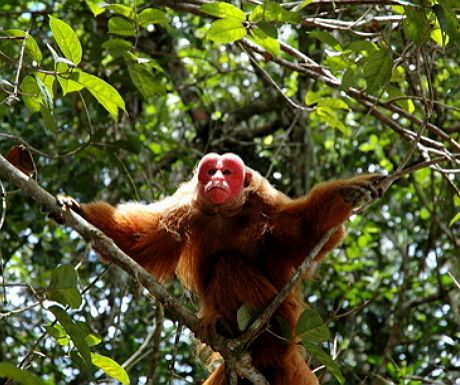 Each country has numerous sights to witness, such as the thousands of species of flora and fauna living in over 50 national parks, wildlife reserves, and sanctuaries found in Peru, or the worlds largest chain of freshwater islands, the Anavilhanas archipelago of Brazil. Enjoy a cruise down the Amazon River, a nature hike packed with wildlife, a piranha fishing trip, or perhaps a cultural exchange with the indigenous people. With so much to offer, the Amazon Rainforest will surely be an exciting adventure to add to your South America vacation.
2. Uyuni Salt Flats (Salar de Uyuni) in Bolivia
Take a walk through the largest field of salt in the world at the Uyuni Salt Flats in the southwestern part of Bolivia. Spanning across an area of more than 10,500 square kilometers (6,524 square miles), the Uyuni Salt Flats are the remnants of a number of prehistoric lakes which previously occupied the Bolivian Altiplano. Not only famous for its large quantities of salt deposits, these salt flats also contain the single largest lithium reserve in the world, which is found in the brine (salt and water mixture) hidden deep beneath the salt flats.
Each country has numerous sights to witness, such as the thousands of species of flora and fauna living in over 50 national parks, wildlife reserves, and sanctuaries found in Peru, or the worlds largest chain of freshwater islands, the Anavilhanas archipelago of Brazil. Enjoy a cruise down the Amazon River, a nature hike packed with wildlife, a piranha fishing trip, or perhaps a cultural exchange with the indigenous people. With so much to offer, the Amazon Rainforest will surely be an exciting adventure to add to your South America vacation.
2. Uyuni Salt Flats (Salar de Uyuni) in Bolivia
Take a walk through the largest field of salt in the world at the Uyuni Salt Flats in the southwestern part of Bolivia. Spanning across an area of more than 10,500 square kilometers (6,524 square miles), the Uyuni Salt Flats are the remnants of a number of prehistoric lakes which previously occupied the Bolivian Altiplano. Not only famous for its large quantities of salt deposits, these salt flats also contain the single largest lithium reserve in the world, which is found in the brine (salt and water mixture) hidden deep beneath the salt flats.
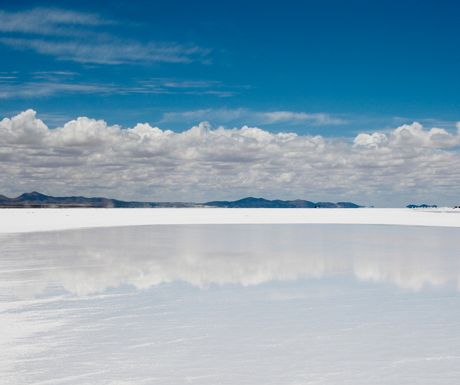 Due to the unusually flat surface, this natural wonder is the perfect backdrop to take some really creative and surreal pictures that toy with artistic perspective. Here is a little insider tip: the best time to visit is shortly after it rains so that the pools of water that collect on the flats create a vivid reflection like something out of M.C. Escher’s sketch pad.
3. Perito Moreno Glacier of Patagonia in Argentina
The glaciers of Patagonia are a must-see for anyone traveling to the southern part of Latin America. Patagonia itself is a semiarid plateau region that spans across the borders of Chile and Argentina, encompassing an area of approximately 670,000 square kilometers (260,000 square miles).
Due to the unusually flat surface, this natural wonder is the perfect backdrop to take some really creative and surreal pictures that toy with artistic perspective. Here is a little insider tip: the best time to visit is shortly after it rains so that the pools of water that collect on the flats create a vivid reflection like something out of M.C. Escher’s sketch pad.
3. Perito Moreno Glacier of Patagonia in Argentina
The glaciers of Patagonia are a must-see for anyone traveling to the southern part of Latin America. Patagonia itself is a semiarid plateau region that spans across the borders of Chile and Argentina, encompassing an area of approximately 670,000 square kilometers (260,000 square miles).
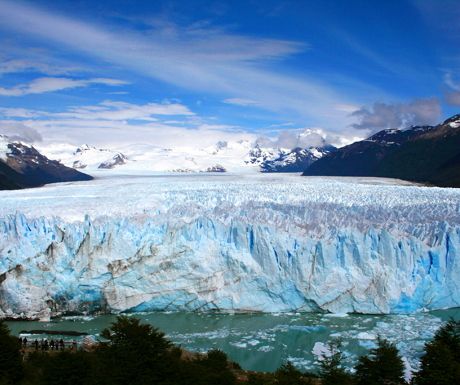 The Perito Moreno Glacier is the largest glacier located in Glacier National Park in the western part of Argentina, which includes a total of 13 glaciers that descend into two large lakes. Not only is it the largest, but Perito Moreno is also the most active glacier in the park, as it is constantly advancing across the surface of Lake Argentina at a rate of about 7 feet per day. It is it one of few glaciers in the world which seems to not have been affected by global warming.
The glacier is truly a humbling experience. Visitors can get up close and personal with the creeping ice giant from a boat on Lake Argentina or hiking along the perimeter of the lake. There is even an option to hike on the glacier itself!
4. Iguazu Falls in Brazil and Argentina
Arguably one of the most majestic natural wonders in Latin America, Iguazu Falls is a J-shaped waterfall that lies on the border of Argentina and Brazil. Designated as a UNESCO World Heritage site in 1984, this breathtaking site measures about 2 kilometers (1.2 miles) in diameter with the cascading waters of the Iguazu River plunging over the Paraná Plateau from a height of approximately 80 meters (262 feet). The monumental drop produces a cloud of spray which creates a subtropical microclimate that supports a wide variety of exotic flora and fauna.
The Perito Moreno Glacier is the largest glacier located in Glacier National Park in the western part of Argentina, which includes a total of 13 glaciers that descend into two large lakes. Not only is it the largest, but Perito Moreno is also the most active glacier in the park, as it is constantly advancing across the surface of Lake Argentina at a rate of about 7 feet per day. It is it one of few glaciers in the world which seems to not have been affected by global warming.
The glacier is truly a humbling experience. Visitors can get up close and personal with the creeping ice giant from a boat on Lake Argentina or hiking along the perimeter of the lake. There is even an option to hike on the glacier itself!
4. Iguazu Falls in Brazil and Argentina
Arguably one of the most majestic natural wonders in Latin America, Iguazu Falls is a J-shaped waterfall that lies on the border of Argentina and Brazil. Designated as a UNESCO World Heritage site in 1984, this breathtaking site measures about 2 kilometers (1.2 miles) in diameter with the cascading waters of the Iguazu River plunging over the Paraná Plateau from a height of approximately 80 meters (262 feet). The monumental drop produces a cloud of spray which creates a subtropical microclimate that supports a wide variety of exotic flora and fauna.
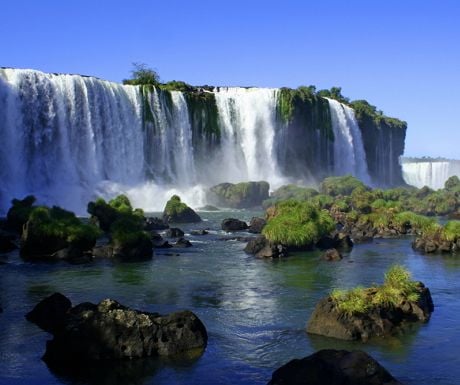 5. Cal Orcko dinosaur footprints in Bolivia
Just when you thought Latin America couldn’t get any better, they throw dinosaur fossils in the mix! Located in Sucre, Bolivia, the Cal Orcko cliff displays more than 5,000 tetrapod (four-legged) footprints of 15 dinosaur species from 68 million years ago. The footprints of Cal Orcko are the largest deposit of fossilized dinosaur footprints in the world from the Maastrichian stage of the late Cretaceous period, the last age of the dinosaurs.
At first glance, it appears that the dinosaurs defied gravity and scaled the cliffside, but the 110-meter (360 feet) high and 1,200-meter (3,937 feet) long slab of rock protruding from the earth is actually the result of millions of years of violent plate tectonic movement.
Paleontologists hypothesize that the footprints became preserved after a volcanic eruption emitted large amounts of ash which settled over the fresh prints impressed in the clay. Over millions of years, layers of sediment continued to bury the footprints and slowly began to turn into rock. In 1994, the footprints were unearthed during regular digging operations of what used to be a cement quarry. Since their discovery, the footprints have become a main attraction in Bolivia and a dinosaur theme park has been built for the thousands of visitors who come to witness this spectacular sight and learn about the giant beasts that roamed the earth millions of years ago.
6. Lake Titicaca of Peru and Bolivia
Lake Titicaca is the worlds highest navigable lake situated at an altitude of more than 3,800 meters (12,467 feet) above sea level. The lake lies on the Altiplano of the Andes Mountains which straddles the border between Peru and Bolivia. More than 70 islands dab the lake, including the intriguing man-made Uros Floating Islands, made of reeds and inhabited by the native Aymara people for the past 600 years.
5. Cal Orcko dinosaur footprints in Bolivia
Just when you thought Latin America couldn’t get any better, they throw dinosaur fossils in the mix! Located in Sucre, Bolivia, the Cal Orcko cliff displays more than 5,000 tetrapod (four-legged) footprints of 15 dinosaur species from 68 million years ago. The footprints of Cal Orcko are the largest deposit of fossilized dinosaur footprints in the world from the Maastrichian stage of the late Cretaceous period, the last age of the dinosaurs.
At first glance, it appears that the dinosaurs defied gravity and scaled the cliffside, but the 110-meter (360 feet) high and 1,200-meter (3,937 feet) long slab of rock protruding from the earth is actually the result of millions of years of violent plate tectonic movement.
Paleontologists hypothesize that the footprints became preserved after a volcanic eruption emitted large amounts of ash which settled over the fresh prints impressed in the clay. Over millions of years, layers of sediment continued to bury the footprints and slowly began to turn into rock. In 1994, the footprints were unearthed during regular digging operations of what used to be a cement quarry. Since their discovery, the footprints have become a main attraction in Bolivia and a dinosaur theme park has been built for the thousands of visitors who come to witness this spectacular sight and learn about the giant beasts that roamed the earth millions of years ago.
6. Lake Titicaca of Peru and Bolivia
Lake Titicaca is the worlds highest navigable lake situated at an altitude of more than 3,800 meters (12,467 feet) above sea level. The lake lies on the Altiplano of the Andes Mountains which straddles the border between Peru and Bolivia. More than 70 islands dab the lake, including the intriguing man-made Uros Floating Islands, made of reeds and inhabited by the native Aymara people for the past 600 years.
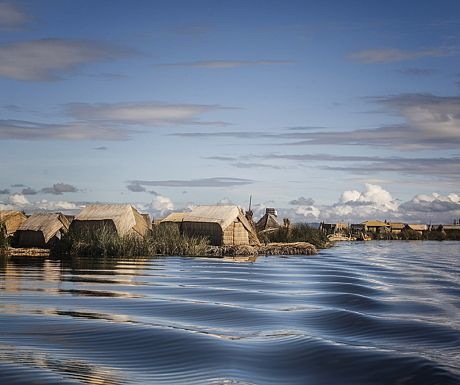 With its tranquil and surreal scenery of picturesque mountains piercing the heavens reflected in the mirror-like waters, Lake Titicaca is considered the sacred birthplace of the Inca Civilization, where legend tells that the sun god, Inti, sent his son and daughter, Manco Capac and Mama Ocllo, to bring civilization and religion to the primitive people. The two rose from the lake and traveled to Cusco to establish the Inca Empire, converting the people along their way.
7. Marble caves of Patagonia in Chile and Argentina
Located in the glacial lake, Lake General Carrera (also called Lake Buenos Aires), the Marble Caves of Patagonia are the result of thousands of years of wave erosions on boulders made of solid marble. The caves are only accessible by boat or kayak from either the Argentina or Chile side and are truly a magnificent sight to behold.
With its tranquil and surreal scenery of picturesque mountains piercing the heavens reflected in the mirror-like waters, Lake Titicaca is considered the sacred birthplace of the Inca Civilization, where legend tells that the sun god, Inti, sent his son and daughter, Manco Capac and Mama Ocllo, to bring civilization and religion to the primitive people. The two rose from the lake and traveled to Cusco to establish the Inca Empire, converting the people along their way.
7. Marble caves of Patagonia in Chile and Argentina
Located in the glacial lake, Lake General Carrera (also called Lake Buenos Aires), the Marble Caves of Patagonia are the result of thousands of years of wave erosions on boulders made of solid marble. The caves are only accessible by boat or kayak from either the Argentina or Chile side and are truly a magnificent sight to behold.
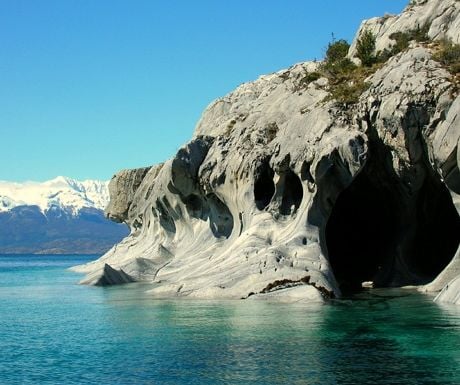 The best opportunity for photos is in the early morning, with clear skies and calm waters in order to capture the clear turquoise waters reflecting on the smooth white surfaces of the marble formations.
8. Paleorrota in Brazil
Paleorrota is a vast paleontological geopark located in Rio Grande do Sul in southern Brazil. Covering an estimated 83,000 square kilometers (51,673 square miles), the geopark boasts hundreds of thousands of prehistoric rock formations, flora and fauna fossils, and petrified trees that date back to the early Triassic and Permian periods more than 280 million years ago. These fossils are some of the oldest paleontological findings ever discovered. In fact, the remains of one of the oldest species of dinosaurs were uncovered on this site less than two decades ago.
9. Colca and Cotahuasi Canyons of Peru
Just northwest of Arequipa deep in the Andes Mountains of Peru lay the worlds two deepest canyons, Cotahuasi Canyon and Colca Canyon. These two natural wonders are formed by the two rivers, the Cotahuasi and the Colca, which wind through the mountains cutting more than 4,000 meters (13,000 feet) into the earth, more than twice as deep as the Grand Canyon of Arizona in the United States.
The best opportunity for photos is in the early morning, with clear skies and calm waters in order to capture the clear turquoise waters reflecting on the smooth white surfaces of the marble formations.
8. Paleorrota in Brazil
Paleorrota is a vast paleontological geopark located in Rio Grande do Sul in southern Brazil. Covering an estimated 83,000 square kilometers (51,673 square miles), the geopark boasts hundreds of thousands of prehistoric rock formations, flora and fauna fossils, and petrified trees that date back to the early Triassic and Permian periods more than 280 million years ago. These fossils are some of the oldest paleontological findings ever discovered. In fact, the remains of one of the oldest species of dinosaurs were uncovered on this site less than two decades ago.
9. Colca and Cotahuasi Canyons of Peru
Just northwest of Arequipa deep in the Andes Mountains of Peru lay the worlds two deepest canyons, Cotahuasi Canyon and Colca Canyon. These two natural wonders are formed by the two rivers, the Cotahuasi and the Colca, which wind through the mountains cutting more than 4,000 meters (13,000 feet) into the earth, more than twice as deep as the Grand Canyon of Arizona in the United States.
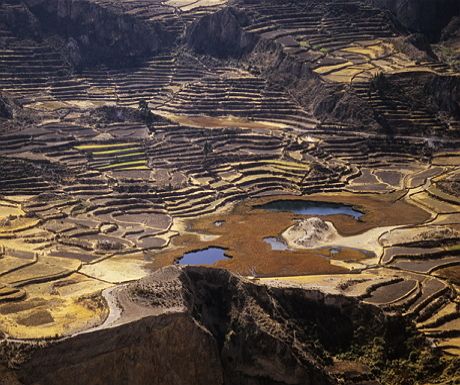 Cotahuasi Canyon is slightly deeper than Colca Canyon by about 170 meters; however, Colca Canyon remains the more popular of the two because it is more easily accessible and in closer proximity to more developed cities such as Arequipa and Chivay.
Nonetheless, both locations are known for some of the worlds best hiking trails, Class V whitewater rapids, rock climbing, and untouched natural beauty. The canyons are home to rare and endangered wildlife only found in the high altitudes of the Andes Mountains, most notably the majestic Andean Condor, which is one of the largest birds of prey in the world with a wingspan of about 3 meters (10 feet). Visitors of Colca Canyon can catch a glimpse of this regal creature in flight through the the breathtaking scenery of the mountainous backdrop at the Mirador Cruz del Condor just outside of the small town of Cabanaconde.
10. Galapagos Islands of Ecuador
Situated about 970 kilometers (602 miles) off the Pacific coast of Ecuador near the equator, the Galapagos Islands are one of the worlds most renowned locations for rare species and practically untouched nature. It is estimated that about one quarter of the species of fish, at least half of the plants, and nearly all of the reptiles cannot be found anywhere else on the planet. Formed by the eruptions of underwater volcanoes and never actually attached to any other landmass, it is mystery as to how the first species of animal even arrived to the archipelago in the first place.
Cotahuasi Canyon is slightly deeper than Colca Canyon by about 170 meters; however, Colca Canyon remains the more popular of the two because it is more easily accessible and in closer proximity to more developed cities such as Arequipa and Chivay.
Nonetheless, both locations are known for some of the worlds best hiking trails, Class V whitewater rapids, rock climbing, and untouched natural beauty. The canyons are home to rare and endangered wildlife only found in the high altitudes of the Andes Mountains, most notably the majestic Andean Condor, which is one of the largest birds of prey in the world with a wingspan of about 3 meters (10 feet). Visitors of Colca Canyon can catch a glimpse of this regal creature in flight through the the breathtaking scenery of the mountainous backdrop at the Mirador Cruz del Condor just outside of the small town of Cabanaconde.
10. Galapagos Islands of Ecuador
Situated about 970 kilometers (602 miles) off the Pacific coast of Ecuador near the equator, the Galapagos Islands are one of the worlds most renowned locations for rare species and practically untouched nature. It is estimated that about one quarter of the species of fish, at least half of the plants, and nearly all of the reptiles cannot be found anywhere else on the planet. Formed by the eruptions of underwater volcanoes and never actually attached to any other landmass, it is mystery as to how the first species of animal even arrived to the archipelago in the first place.
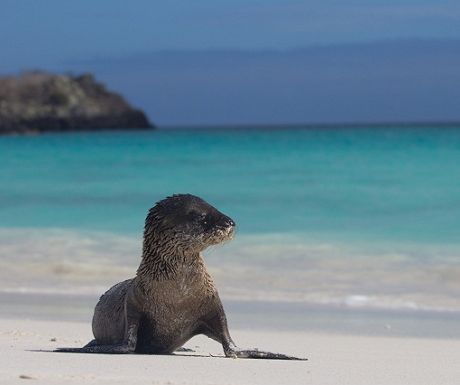 On a visit to the Galapagos, the first thing you will notice is how calm and fearless the wildlife seems. Sea lions, birds, and lizards will barely flinch as you get close for a picture. You can explore the natural beauty of the archipelago by taking a boat tour, snorkelling or scuba diving, and hiking. A trip to Galapagos will make you fall in love with nature over and over again.
Have you visited these natural wonders, or are you planning to add them to your next vacation? Share your experiences in the comment section!
Richard Leon is the General Manager at Peru For Less.
If you would like to be a guest blogger on A Luxury Travel Blog in order to raise your profile, please contact us.
On a visit to the Galapagos, the first thing you will notice is how calm and fearless the wildlife seems. Sea lions, birds, and lizards will barely flinch as you get close for a picture. You can explore the natural beauty of the archipelago by taking a boat tour, snorkelling or scuba diving, and hiking. A trip to Galapagos will make you fall in love with nature over and over again.
Have you visited these natural wonders, or are you planning to add them to your next vacation? Share your experiences in the comment section!
Richard Leon is the General Manager at Peru For Less.
If you would like to be a guest blogger on A Luxury Travel Blog in order to raise your profile, please contact us.Did you enjoy this article?
Receive similar content direct to your inbox.


I’ve been to 4 out of 10, not bad :D
I wish I had known about the dinosaur footprints of Bolivia before I traveled there, it looks really awesome!!! :D
I have been to 8 out of 10! Really hard to choose my favourites, if I was pressed I would go with Galapagos and Amazon. Can’t beat the experience of a night in the jungle and the wildlife diversity of the Galapagos is just breathtaking. Great selection! I would also add Lençois Maranhenses to the selection, have you ever been there?
I’m still at the top half of South America, so I’ve only made it to 1 of 10 so far – but Colca Canyon followed by Lake Titicaca next, can’t wait! There’s nowhere from Colombia on your list, though – surely it needs a mention!!
Lovely pictures. I’ve only managed one of the ten on your list (Amazon rainforest) so my bucket list has just got even longer…
I love this. Stunning pictures! The 4th and 7th natural wonders of Latin America are what I love the most. OMG, I will visit there soon esp that cave. I’m an adventurer and would love to explore that place. :)
I have living in Latin America from long time and being frank, I never visited 5 places among 10 which you have shown. I was shocked when I saw this post and felt bad that I haven’t visited these. I’ll definitely plan and will cover all these places. Keep exploring new places and do let us know.. !! Good Job..!!
I only didn´t set foot on Galapagos but saw some of the islands from a few mile distance (was on a sailboat and to drop anchor there is so expensive so we just kept going)…Love your list, a of your choice would be on my list too if I make one some day!
Have been in Quito for the last 6 days – I will definitely add a couple of these to my trip! Surprised you only included the Galapagos – Ecuador has so many other natural wonders!
The pictures are just stunning. Thanks for creating a “bucket list” that I can easily reference for my travels. So many wonders in this world, so little time!
Ahh all of these are on my bucket list! South America has some insanely gorgeous places, the more I read about it the more I want to go. Maybe I’ll start making my way south haha
Oehf, those pictures look pretty amazing! Latin America is high on my bucket list :)
especially lake Titicaca of Peru and Bolivia
Amaaaazing Pictures and Places, I’m still missing going to South America so this was really useful Thanks so much :)
What an incredible list! After traveling through Latin America for three years we can proudly tick a lot of those off the list. Although traveling on a budget meant the Galapagos and Patagonia didn’t make the cut.
I’ve not been to South America, but these photos make me want to rethink that!The rain forest and the salt flats are high on my list!
Great selection you’ve got here. I still need to see Iguazu falls and Porito Moreno, but hopefully I’ll soon on a trip to South America :)!
We are just dying to go to South America and this post didn’t help! We will have to incorporate these stops into our trip, our list is growing longer by the minute!
I haven’t been to South America yet but I’ll be checking these out, there a few that I’d never even heard of.
Every picture in your article is a new: Wow! effect. I really want to go to Latin America, especially to the Salar de Uyuni in Bolivia.
HI, nice places, I would include Chan Chan, Senora de Cao, Senor de Sipan, Huanchaco beach, Puerto Pizarro in the North of Peru.
A high quality list of Latin American attractions here but I have to say that my standout attraction has to be Iguazu Falls in Argentina. I have a real desire to see the leading waterfalls around the world and so far my top visit has been Niagara from both the American and Canadian sides. But Iguazu to me is a hidden gem. It doesn’t get the media attention as much as Niagara or Victoria but it is equally if not more breathtaking.
Patagonia really seems like one of those life-changing travel experiences. This is a great round-up and will definitely result in some new destinations on my list.
All those are excellent choices, but you forgot the highest (and most beautiful) waterfall IN THE WORLD… Angel Falls!… in Venezuela.
It looks like such a stunningly beautiful place, I want to visit so much! Especially the Galapagos islands!
South America is such an amazing place. If someone asked me what was my favorite place there I wouldn’t be able to decide!
Amazing article! That’s a pity you didn’t include Atacama desert in Chile and Eastern Island! I travel to Atacama last month and it’s just stunning! And has a very beautiful salt flats.
I really wanna check out all these. I am surly planning this tour on new year eve. Great one. Thanks!